Fun with Music: String Instruments
This post, “Fun with Music – Sting Instruments”, is written in collaboration with Shannon Wijnker, who used to blog on Mamamusing. Shannon is a music teacher and mother of four.
Shannon writes:
As a child, I was always fascinated with string instruments. In fact, the violin was the first instrument that I learned how to play. After listening to someone play the violin, I walked up to them and told them that I wanted to start lessons (not even consulting my parents of course!). One thing led to another and my studies in music began.
I find that children are familiar with the guitar, but have little to no knowledge of any other instruments in the string family. Especially in our school system, a majority of the children are only exposed to woodwind and brass instruments.
Just the other day I was watching Sesame Street with my kids and they had a skit about musical instruments and vibrations. I thought to myself…. Yes! String instruments are the best way to teach children about vibration! Drawing a bow across the strings is a great visual and tangible way to demonstrate this concept for young children. My daughter just loves to watch them, because she thinks they are cool J. All musical instruments make vibrations, but string instruments are the best example. You can also talk about pitch and that the bigger the instrument gets, the lower the vibration will sound. The smaller the instrument, the higher (and as faster) the vibration will sound. Play a game with your child and have them compare two different instruments and guess which one will make the higher/lower sound.
Content:
Playtime
Craft
Musical Outings
Story Time
Games Online
Related Posts
Playtime
More from Shannon:
One of my favourite string performers is Yo Yo Ma. He plays the cello and has an amazing talent for making the music sound so expressive. You can find a plethora of videos on YouTube. Natalie MacMaster is a very talented Canadian violin player. Another great example to listen to! (and a completely different style of playing)
Also, introduce your child to listening to music by playing all four (4) movements of Vivaldi’s Four Seasons. This is played by a string quartet (4 string instruments: 2 violins, viola and cello) and each movement depicts a different season. Have your child draw a picture of what season they hear when listening to the music. (Only one movement per seating!)
Craft
Box Guitar
Materials Needed:
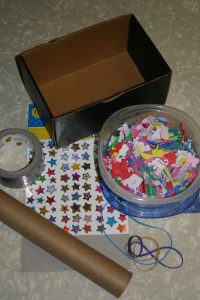
Cardboard shoe box or similar
Rubber bands of different sizes
Paper, crayons, markers, stickers, etc. to decorate your instrument
Glue
Scissors
Paper towel roll (optional)
Instructions:
1) Cut your paper to the size you need to cover your box. (I was able to eliminate the first two steps because the box I had was solid black.)
2) Decorate the paper then glue it to the outside of your box. (We just used stickers this time. Stickers are a great fine motor activity for little hands.)

3) Cut a hole in one end of the box; just big enough to fit the end of a paper towel roll through.(Since we just used stickers, I cut the hole in the end of the box before we attached the stickers.)
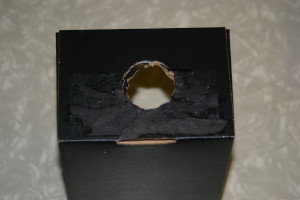
4) Make small cuts on one end of the paper towel roll.
5) Push the end with the cuts through the hole in the end of the box.
6) Spread out the cut pieces and add some glue.
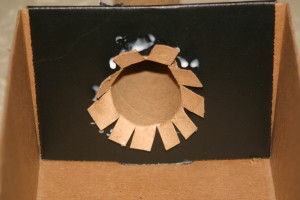
7) I then used duct tape to make sure the paper towel roll held in place.
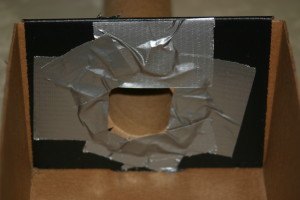
8) Have a grown-up cut little slits on the long sides of the box. Make the same number of slits as the rubber bands you are going to use. This will help keep the rubber bands in place rather than sliding around as the child plucks them.
9) Arrange your rubber bands from largest to smallest.
10) Stretch them around your decorated box and slip them into the slits.
11) Now pluck away. Can you hear a difference between the largest rubber band and the smallest?
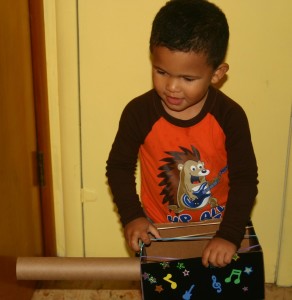
Musical Outings
Stringed instruments cover everything from guitar and banjo pickin’ to violins and cellos in a symphony. In Indianapolis, you can find many places that give free outdoor concerts during the summer. Maybe you have the same opportunities in your area. Outdoor concerts are a great way to introduce your children to live music because they can sit in their own lawn chair, on a blanket or even get up and dance around a little. Expose your children to many types of music. Take the time to talk about what they are hearing, how it makes them feel and the different instruments they are seeing and hearing.
Shannon from Mamamusing wants you to know: “In London, there are several outdoor concerts and festivals in Victoria Park during the summer. One of the best is Sunfest (beginning of July). You can check out a video of my kids enjoying the multicultural music and dancing by clicking here.”
Story Time
Strings (Instruments and Music)
by Daniel Nunn
Reading Level: Ages 4 to 8 yrs old
This book makes a great introduction into string instruments. The text is simply a sentence or two on each page. The illustrations are actual pictures of string instruments and people playing them. Your child will get to see the many different sizes and shapes of string instruments. Have fun learning about string instruments.
Strings (The Musical Instruments of the World)
by Barrie Carson Turner
Reading Level: Ages 6 and up
This book has a lot of information in it but it is laid out nicely. The book introduces you to 19 stringed instruments from around the world. You will find some instruments that are familiar to you and there are others you may have never seen before. Each instrument has it’s own page so if you just want to cover the familiar ones or if you want to break the book up into different sessions it is laid out well for that. Although this book is for a little bit older child you could use it with a younger child by becoming familiar with the text and then simply point out and discuss the different instruments rather than reading it word for word.
The Violin and Other Stringed Instruments (Let’s Make Music) by Rita Storey
Reading Level: Ages 6 and up
This is a very informative book for children that would like to learn a little more about what string instruments are and how they work. Your child will learn about the different sizes of string instruments. They will learn how different string instruments are played; some plucked or strummed with fingers, while the musician uses a bow or pick on others. Your child will learn why some string instruments don’t need electricity to be played and others do. It’s a great book that gives a little more detail, as to how string instruments work, but is still very interesting.
Games Online
Shannon from Mamamusing shares some fun online games:
Now that you have introduced your children to some of the various instrument families in the orchestra, you may want to visit The Young Person’s Guide to the Orchestra. This is a website created by Carnegie Hall which is a wonderfully FREE interactive online game for young children to explore and learn more about the various instruments of the orchestra. You will need to use a computer, because the game requires Adobe Flash, which you can download for free (if you don’t already have this utility installed on your computer).
There is also a wonderful set of books for children ages 4 to 8 years old that helps them learn different musical concepts. Along with the books the author, Sharon Burch, has a website with coloring pages and games for your child to enjoy and enhance their learning experience: Freddie the Frog Games and Coloring Pages
Related Posts
Music at an Early Age by Shannon at Mamamusing
Fun with Music: Overview
Fun with Music: Percussion Instruments
Fun with Music: Brass Instruments
Fun with Music: Voices
Fun with Music: Keyboards


